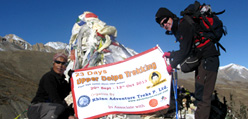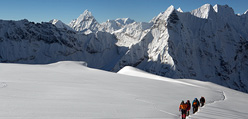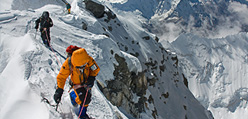Email : info@nepaltrekkingpackage.com
+977 - 01 - 4701300
Trekking preparation
When to go
For all of our routes and itineraries, the best time to trek is either between March and June, or September and November. This will not only result in a more comfortable trekking experience, but will also provide you with the best chances of clear skies, meaning your views of Nepal’s glorious peaks will be unobstructed.
It is, of course, possible for you to trek during the off-season, but please do keep in mind that during Winter, it will be extremely cold, and may make camping rather uncomfortable. During the monsoon season, conditions will be generally cloudy and rainy, and in low-lying forest areas, you can expect to be beset by leeches! Trekking during that time of the year is not for the faint-hearted, but we are happy to arrange expeditions if you desire. During this time the weather is generally fine and the skies clear. It is possible to trek out of season, but expect lots of rain (and leeches) during the monsoon and severe cold and closed passes during the winter months.
Experience and fitness
We provide a range of trekking options, suitable for all age groups, from five to 85. We provide guides and porters (who are available to carry all of your possessions and equipment), and on most treks you will be able to stay in teahouses. If you’re comfortable walking for a few hours a day, and don’t mind the occasional slog or scramble uphill, then most of our routes will be appropriate for you.
Some of our longer routes, particularly those that involve crossing high mountain passes or entering remote regions will demand a higher level of stamina and physical fitness. For climbing, it is often useful to have had some prior climbing experience. Please use our ratings system as a guide.
Equipment
You will require a sturdy, comfortable hiking boot, and are advised to bring a sleeping bag, and liner, essential clothing, and a torch. It is always advisable to travel light, and we can if necessary store your non-essential luggage for you securely while you are trekking. While you may be hiring a porter, please keep in mind that our staff are very strong, but not supermen! Please see our equipment page for more details.
Hiring support
It is up to you whether you wish to travel alone, with a group, or with other independent travellers. We strongly recommend that you travel with a guide – there are reports of tourists going missing even on relatively well-populated trekking routes, and it is a great way to help support the local economy. Whether or not you take a porter to carry your belongings depnds entirely on your own preference and level of physical fitness, but please be advised that if you do not take a porter, your guide will not be able to help carry your bags.
Permits
Permits are only required for certain treks, but a recent ruling brought in by the Trekking Association of Nepal requires that all trekkers register with the Trekking Information Management System (TIMS), which Rhino will be happy to arrange on your behalf via the Nepal Tourism Board.
For treks that require permits, we will also be able to assist you in applying for them. This process usually does not take long, but we can do it on your behalf as part of our package of services, so that you don’t waste valuable time queuing and filling out forms!
Rescue insurance
It is very important to make sure you are fully insured for any expedition, in the event of accident or injury. It is your responsibility to check with your provider before travel that the altitude you will trek to is covered, as well as helicopter rescue – which can be very expensive to pay for if your insurance does not include this coverage.


